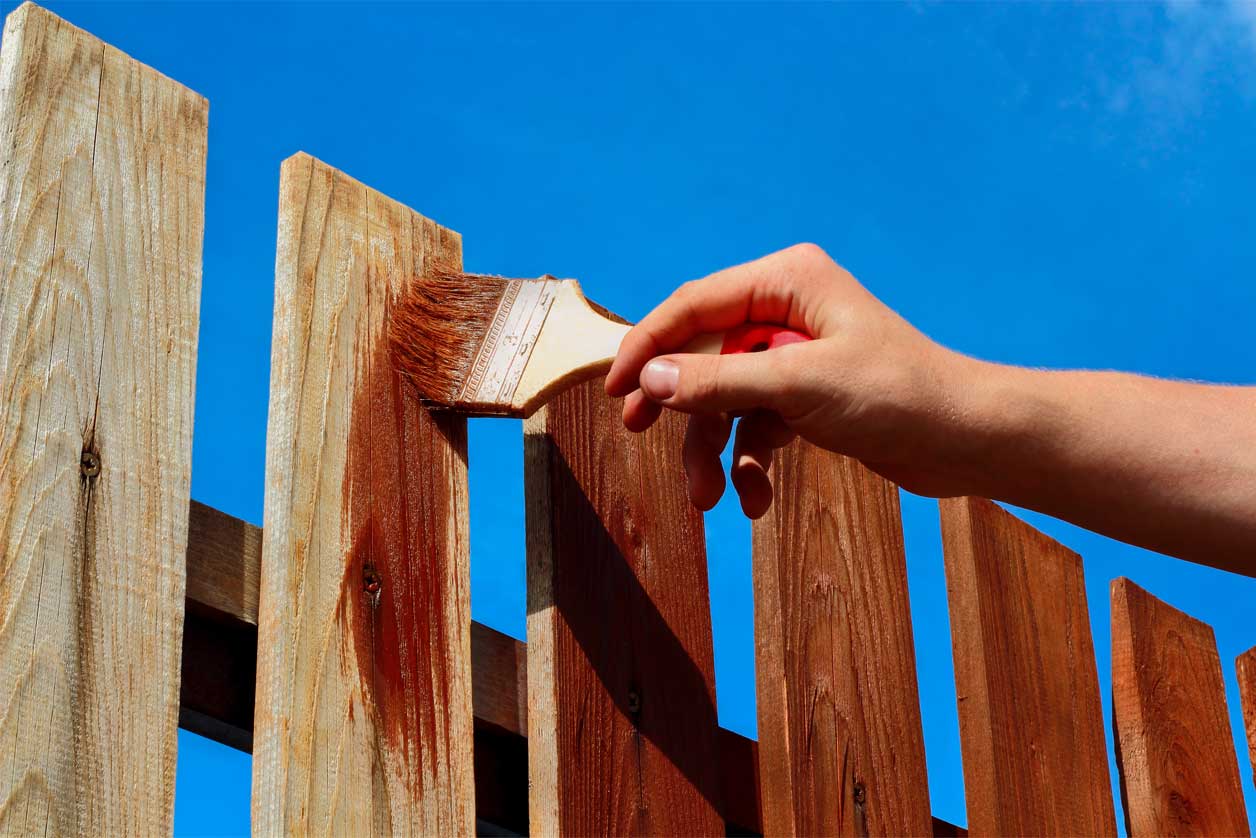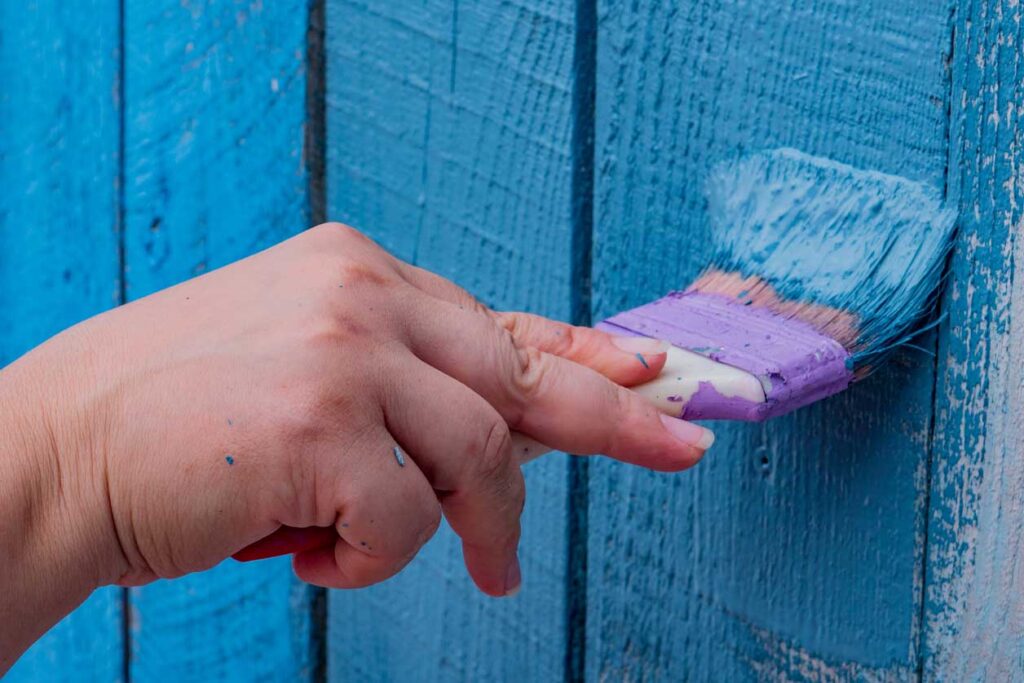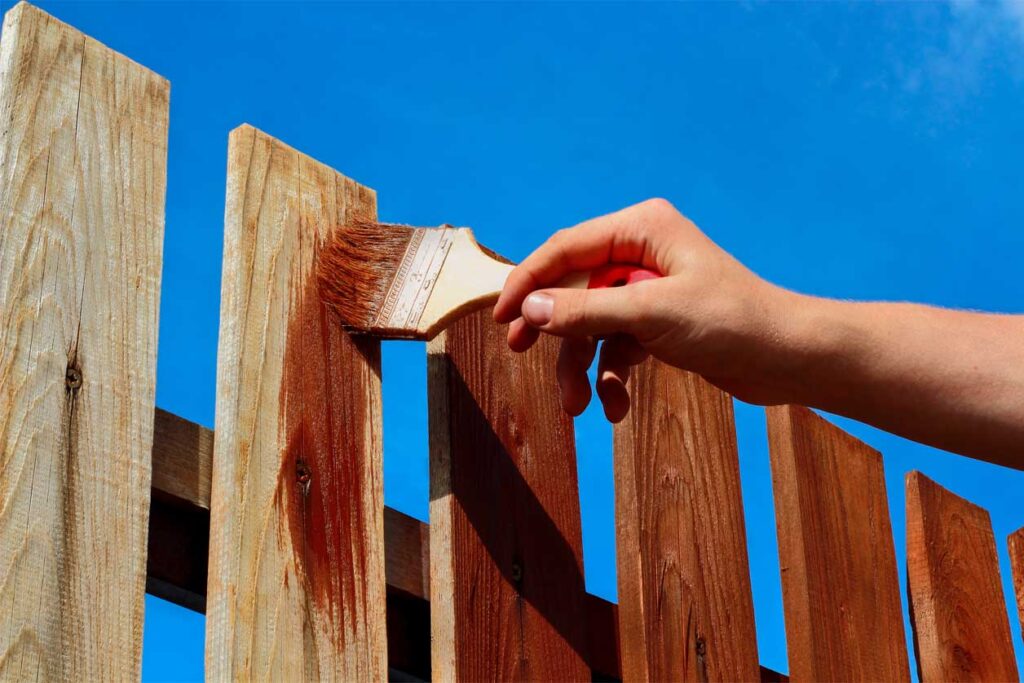Which is Better? Staining a Fence or Painting a Fence?
Editorial Team
November 6, 2022

Atlanta property owners are always looking for ways they can increase the property’s marketability and its aesthetic appeal. If you’re like most people, then you already know that improving the condition of your fences will definitely increase their value and improve their look.
Deciding On What To Do With Your Wooden Fence
Because weather and environmental conditions will eventually change the appearance of your fencing, many homeowners choose to paint their fence or stain their fence in order to restore them back to their original state. You should know the difference between staining and paint before deciding whether to stain or paint your fence.
If you opened two cans of paint next to each other, you’d be able to tell which one was thicker just by looking at them. When you paint a wooden surface, the paint is applied to the surface of the wood. When you use paint to cover up an existing stain, it goes right into the pores of the surface, like frosting on a cake. They’re similar because they both help keep wood fences looking good for longer periods of time. However, they each have their own set of advantages and disadvantages.
Staining Your Atlanta Fence
Stains are good options for homeowners who are in a time crunch because they’re easy to use and don’t require any special tools. Regardless of whether you have little children or animals that roam freely in your yard, or you do a large amount of landscaping, stains dry much faster than regular paint. You don’t need as many coats to achieve your preferred finish. Because stained wooden fences tend to fade over time, some homeowners choose to repaint them instead. Stains will allow homeowners to preserve the natural characteristics of their wooden floors while enhancing them with a beautiful finish.
Painting Your Atlanta Fence
Painting gives people more choices when they’re looking for ways to improve their homes One common misconception with wood stain is that it doesn’t require reapplication. It actually does. Stains may be easier to remove from paint than they are from wood. You can accent your personal style by using different types of paints. Stains come in one single flat color, whereas painting allows you to choose from a variety of available hues. If your existing fencing has already been painted over by someone else, you can repaint it with another color to give it a new look. If you try to apply a coat of paint to your wooden fences, it won’t stick because it won’t be absorbed by the wooden surface.
These Are Best Woods for Staining
- Oak (Red Oak or White Oak)
- Ash
- Chestnut
- Hickory
Do Not Stain With These Woods
- Pine
- Cherry
- Maple
- Birch
Protecting Your Atlanta Wooden Fence
Both paints and stains protect your wooden fence from rotting, molding, and insects, as they also help prevent weather damages. Protecting your fences against extreme weather conditions is particularly important in Atlanta because of its varied climate. You can also paint and stain your wooden fences to keep them looking good for years to come. Either option is better than not doing anything at all. If you want to protect your fence from rot, extend its life, and minimize the amount of time and effort needed to maintain it, then you should probably put up some kind of covering.
Cost of Painting and Staining Your Fence in Atlanta
It can be difficult to accurately compare the costs of staining and painting when evaluating which option is most economical. The price per gallon of stain is usually cheaper than that of paint, however, you will need more bottles of stain to adequately coat your wooden fencing. Paint doesn’t penetrate into the grain of the wooden surface as deeply as stain does, so it requires less maintenance in the long run.
Painting makes a thick initial barrier, but it also chips, peals, and wears out quickly, making the fence look old and worn. On the other hand, stain just wears off over time and doesn’t need to be replaced as frequently, so you may end up buying fewer products over the years. Speaking of maintenance, repainting is a less time-intensive project. With stains, rather than scraping or sanding off old paint to remove it before applying a new coat, you simply need to wipe down the surface and then re-stain it. Outdoor paints usually take longer than indoor ones to dry because they’re exposed to sunlight for several hours after application.
Adding Color to Your Outdoor Wooden Fence
With paint, you can achieve any color you desire for your wood fence. If you have particular tastes or believe a certain color will best complement your Atlanta area property, you can easily achieve that look. However, you don’t have to forego color simply because you stain your fence. While many people associate staining with neutral colors that highlight the natural look of wood, you can find vibrant stains in a variety of colors, including blue, green, purple, indigo, grey, and red. If you like the natural look of the wood, though, you can opt for a transparent or semi-transparent stain.
The Right Fit for Your Wood
Depending on the type of material you use for your fence, whether you paint or stain it may be better suited. Cedar fences, in particular, are better suited for staining. Painting keeps the wooden surface from breathing, which helps prevent it from rotting. If you treat your lumber before staining, you won’t get as deep a color as you would if you didn’t treat it at all. When deciding whether to stain or paint your wooden fences, you’ll need to consider your specific type of fencing.
Paint
Most people know that horizontal surfaces, such a decks, should be stained before they’re installed. True enough, but it doesn’t hold up well against foot traffic. However, because no one but the cats would be climbing your fences, you have more leeway with vertical surfaces than horizontal ones.
One of its greatest advantages is variety. You can choose from a wide variety of paints and finishes when painting your fence. If you want a purple fence to go with the wisteria growing up your front door, then get one! Painting is the best option. If you want to match the color of your fence, you can use any kind of wood stain, but if you’re looking for a glossy finish, you need to use a clear coat. Most paints dry to the point where they’re completely dry after one hour and are fully dry after four to eight hours. It usually sets up within 48 hours.
But there are some drawbacks too. It’s more expensive than regular paint, requires priming, can take longer to achieve color uniformity and may chip or flake.
Stain
Stains are a completely different type of material. Once you open the can, it becomes clear that it’s thinner than expected. If you want to change the color of the wood, instead of painting it directly onto the surface, soak it in a solution for several hours before applying paint. Paint requires priming, which means you need to work harder to achieve a uniform color. Stains are easier to use because they’re less forgiving. If you have a wood fence with a texture or roughness, stain will work much more effectively than painting. Enhancing raw wood’s natural beauty makes it look better than if it were left alone. If you’re painting a highly absorbing material, your paintbrush may surprise you by how long it takes to get covered in paint.
Manufacturers have added new stains to their lineups. Consumers can choose any shade from clear to a slight tint to completely opaque. You usually won’t need more than one layer of stain. Unlike paint, stains don’t peel, break or blister.
But stains can be tricky. To properly dry your fence, wait until the weather reaches at least 50 degrees Fahrenheit and there isn’t any rainfall forecasted for at least two days before staining.
Does paint or stain last longer on a fence?
Stains tend to last longer than paints – but they’re harder to apply. Remember that stains will eventually fade away and may require re-application, even if they last longer than normal paints.
Maintenance
Stains tend to last longer than paints – but they’re harder to apply. Remember that stains will eventually fade away and may require re-application, even if they last longer than normal paints.
Regularly maintaining painted and stained fences requires similar upkeep. Repainting your walls regularly helps prevent them from peeling and cracking. You should plan to re-apply paint at least once every three years, and perhaps even more often if you live in an You’re not alone! If you have any fence related questions, please contact us.
Should you prime a fence before painting?
The short answer is “yes.” Primer coats fill in the pores of the wooden surface and act as a base coat for subsequent layers of paint. They help the next layer of paint adhere better and provide greater coverage. New fence construction uses chemicals that bleed through paint’s surface and cause premature cracking, peeling, or blisters. An acrylic primer will work to seal any chemical residue from the previous painting and protect the new one from fading too quickly. Acrylic latex paints are the traditional choice for painting walls, ceilings, and trim. However, there are now more high-quality acrylic paint options available.
Allow Spectrum Fence of Atlanta to Paint or Stain Your Fence
We at Spectrum Fence strive for excellence in every aspect of our business. Doing a DIY project can be a lot of hard work. If you don’t take the necessary steps to ensure that the job gets completed correctly, then chances are that it won’t get finished at all. We’re here for you! Call us today for a free estimate, to learn more about our high-end products, or to ask any questions you may have.
Categories
Call Spectrum Fence
Painting or staining your fence can quickly overwhelm you. Call the experts and get it done right.
- (770) 367-2925
- Servicing All Atlanta



